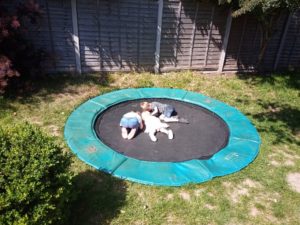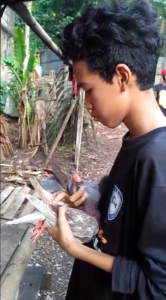Elisabeth Barratt Hacking and Hannah Hogarth, Department of Education, University of Bath
Biodiversity and the Global Pandemic
World Environment Day 2020 provides an opportunity to reflect on how children have experienced nature during the pandemic: locked down indoors with no access to playgrounds, nurseries and schools. Drawing on our research about 'childhoodnature' - a new concept which conveys that children are nature - we reflect on the awakening to nature we have observed in recent months.This is an awakening to:
- humans are nature;
- nonhuman and human life is interconnected and interdependent;
- biodiversity is vital for the health of people and planet;
- every child needs regular access to nonhuman nature including nearby natural spaces.
World Environment Day is also a day for action in relation to a pressing environmental issue, which this year is biodiversity. Biodiversity is the variety found in nature, in animal and plant life. The context of the 2020 World Environment Day is unprecedented with its stark reminder of the vital importance of biodiversity for human and planetary health and the significance of nature in children’s lives.
Biodiversity is fundamental to the interconnected web of life on planet earth. Healthy ecosystems support all life on the planet, providing soil and water, climate regulation, pest control and much more. But human activity is having a detrimental impact on biodiversity, and we are destroying habitats at an alarming pace, from ponds to tropical rainforests.
But what has biodiversity got to do with the coronavirus pandemic? As humans encroach into natural habitats, contact between wildlife, farm animals and humans increases the risk of diseases, which can be transmitted between animals and humans. The World Health Organisation suggests it is likely that SARS-CoV-2 has such a source (WHO, 2020).
So, what can we do about the threats to biodiversity? Living within the interconnected web of relations in nature, rather than exploiting nature for the sole benefit of humankind, is one answer to this question. This aligns with a posthuman perspective in which nature is viewed as an interdependent web of life, nonhuman and human (Taylor, 2016). Consequently, we need to learn from children’s relations with nature and encourage educational settings to provide more opportunities for time in nature for all children.
Provocations of a Pond in the Pandemic
One of us, Hannah, has four young children who have been at home during the lockdown. Here, Hannah reflects on her children’s experience of discovering a pond in their garden during lockdown and the provocations it provided for play and learning.
A week into lockdown, my youngest child was lying on the sunken trampoline in our garden, fascinated by something underneath. The other children lay down to look and they noticed that in the water that had collected beneath were hundreds of newly hatched tadpoles and vibrant, green plants. An ecosystem had developed, unknown, and provided the children with an opportunity to learn. As my research area is children’s play in nature, it was a great opportunity to observe my children’s response to the pond and its provocations.
-
Ecological knowledge
The children began by asking lots of questions. How did they get here? Where are their Mums and Dads? What are they going to eat? How will they grow? After a week of home learning, where I had struggled to ignite their interest, they were suddenly keen to learn about the life cycle of a frog and how this ecosystem could be sustained.
-
Imaginary play and story telling
Soon their investigations became more playful: they made elaborate stories about how they had arrived there and played a game where they were the tadpoles having the adventures they imagined the tadpoles were having.
-
Relationships and change
They questioned the personality traits of the tadpoles – wondering whether one was pushing the others around. They debated why some grew bigger than others – ‘that one must be greedy’, one child exclaimed ‘or just stronger’ said another. They asked why some would travel to different areas of the ‘pond’ and form smaller groups. My younger son was fascinated by how the tadpoles changed, ‘will my personality really be with me when I’m a grown up?’. Maybe he had imagined he would, at some point, go through a similar metamorphosis. The children also questioned what the tadpoles really needed – something that was poignant to me at a time when the six of us were confined to our house. It provoked questions and thoughts about complex aspects of interaction, relationships and personalities.
-
Connection to nature
During a time when children had to maintain their distance from humans outside their families, they could watch these tiny creatures go about their lives as normal – huddling up with each other, squeezing through gaps in crowds to get to other parts of the pond – just as humans would have done before the pandemic. They seemed to find connection with these creatures. On one occasion, after some very warm weather, a small part of the pond had dried and left two dead tadpoles. It gave them the chance to discuss why some tadpoles die and others survived. They questioned why the tadpoles had not swum to safety and I explained that sometimes things happen that are out of our control.
Why did it take lockdown to have such a meaningful interaction with nature? It is very likely that frogs and tadpoles had been living under the trampoline in previous years, but with school and busy lives, there was not the opportunity to lie down and look. Certainly, there would not have been the time to spend hours watching them grow and make stories about their lives.
Yesterday, tiny legs started to appear on some of the tadpoles and the children were screaming with excitement. The pond is less than a few meters in diameter and yet having open ended time to revisit this natural space had led them to witness an awe-inspiring aspect of biodiversity.
Hannah’s children showed an awakening to the nature under their trampoline, and to their own nature – growing up and changing like the tadpoles. When children are given the opportunity to be, play and learn with nature at their own pace, a natural relationship with nature emerges. The learning from spending time with this tiny pond is remarkable: ecology and ecosystems, creativity, personal, social and emotional development and connecting with nature in ourselves, our family and other species.
A boy’s life with pigeons
Provocations of a pond provides minority world and relatively privileged perspectives on childhoodnature. However, in our second example, from a Kampung (shanty) in Indonesia, Iki shows that children’s relations with the natural world, whilst unique to each child, are also universal.
Iki is a boy who lives in Bulakan shanty in Jakarta. This community depends on recycling from the rubbish tips. Here pollutants from burning rubbish affect children’s health and wellbeing.
Iki and his family have been in lockdown and his school is closed. It is not typical for children from the shanty to attend school. Iki attended Sekolah Bisa School which provides an education for children from marginalised circumstances. Iki is confined to his home, but the school brings food and educational resources to its students’ doors every day.
Extract from Iki’s composition (written aged 10):
‘I started to know to keep pigeons from a friend … My parents gave me a full support for keeping pigeons. Each day my pigeons multiply, the number of pigeons has increased to 16. Every day I feed the birds with corn. The advantage for me to keep pigeons is that I become consoled and my family too…. The pigeon coop is located 3m behind my house. Once a week I clean the cage with water. The obstacle I face was when the bird likes to lose itself and does not return…. The benefit I am raising pigeons is that I like to play with it …it feels better to play near my house’ (Widdop Quinton et al, 2020).
Iki’s words, photographs and video (the latter will be posted to Twitter) give a small insight into his life with pigeons. They tell a remarkable story about Iki’s relationship with nature and the value he places on it. This is especially astonishing given the deprivations of the environment in which he lives. Iki reminds us that we should not romanticise childhoodnature; we need to ensure children’s nature stories are shared no matter what their circumstances.
Making kin
Musing on the children’s stories suggests new ways of relating to and being in the world. Through spending time with the pond and the pigeons, the children are, in Donna Harraway’s (2016) words ‘making kin’ and ‘making with’. Here the children are ‘making with’ rather than ‘self making’; their learning and wellbeing is evolving with the tadpoles and the pigeons.
Importantly, the examples illustrate two-way benefits. Research has shown that time with nonhuman nature can benefit children's wellbeing. Iki describes the pigeons as consoling him and Hannah’s younger son appears to be reassured that his personality, like the tadpoles, will not change as he gets older. Likewise, making kin benefits nonhuman nature. Louise Chawla’s ongoing ‘significant life experience’ research shows that positive experience of the natural world in childhood contributes to a lifelong interest in sustaining the environment. So, the posthuman view of nature as an entangled web of relations envisages a way of life that benefits all living things, human and nonhuman.
Socially distant but environmentally close
Social distancing is essential in the pandemic and yet an awakening to the need for proximity to nature, especially for children, has been evident in many parts of the world. For example, in the UK we have seen public protests at the closure of city parks and councils turning busy streets into cycle ways and play zones. The impossible has been shown to be possible - this trend must be maintained.
This is not just a romantic notion for the affluent, it is even more important in less privileged and urban communities. Research has shown inequalities in access to natural spaces and unpolluted environments worldwide. For example, the national (England) Monitor of Engagement with the Natural Environment (MENE) has shown how children from disadvantaged and / or black and ethnic minority (BAME) households have less access to natural environments.
Nearby urban greenspace and access to more distant environments is vital for such children. There are many excellent initiatives. For instance, Black2Nature was set up in 2016 by Mya-Rose Craig (Birdgirl), now 17 years old. But, if natural spaces are not available at home or nearby then it’s the job of educators to make it happen for every child.
The pandemic has reminded us how important biodiversity and natural spaces are for children. More children return to schools in England this week, with social distancing expected for some time. This offers a new incentive for schools and nurseries to use natural sites for play and learning. Whilst children cannot be physically close to their friends, they can be close to other living things. The children in our examples show how important this is.
Awakening to nature
For us the pandemic, and the children in our research, have shown more than ever that on World Environment Day, ‘it’s time to wake up. To take notice. To raise our voices. It’s time to build back better for People and Planet.’ Engaging with nature, our own and other living things, should be at the heart of any education system.
Thank you
Thank you to Ikki and the Hogarth children for sharing their stories and photos, and to Mr Adrian Thirkell, founder of Sekolah Bisa School, for his help with this blog.
Elisabeth is Deputy Head of the Department of Education. Elisabeth’s research focuses on the overlapping areas of environmental education, childhood, and global citizenship. Amongst her publications is the new Research Handbook on Childhoodnature.
Hannah is a PhD student whose research focuses on the relationship between children’s play in nature and their emotional wellbeing.
Respond



